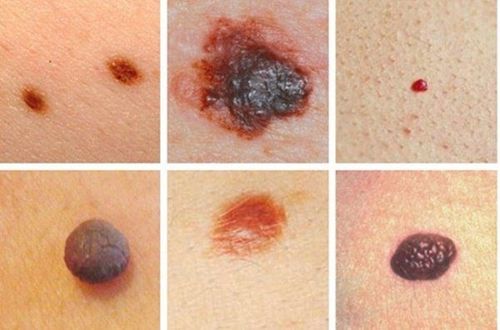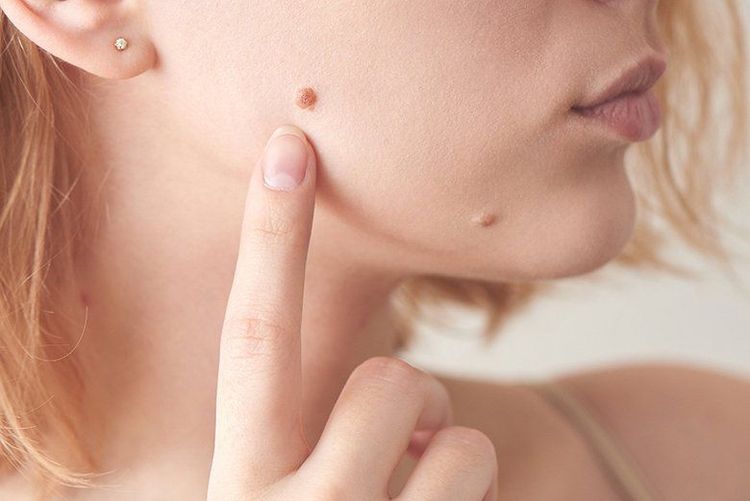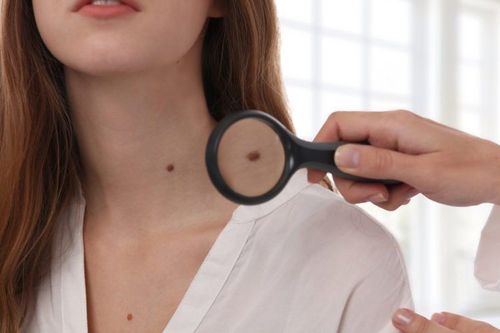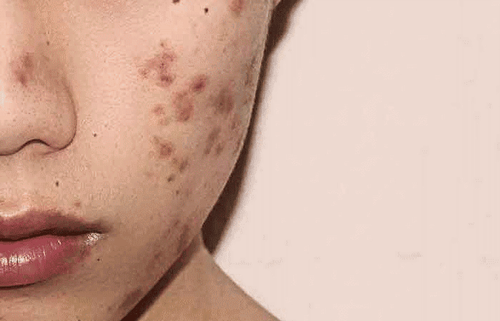Moles vary in their characteristics and most are harmless. They are not contagious and do not cause pain, itching or bleeding. A mole can last up to 50 years. However, see a dermatologist if you suspect that a mole is acting abnormally.
1. What are moles?
The skin is the largest organ of our body. Skin moles (“nevus” or “nevi” is the medical term) are growths on your skin that range in color from your natural skin tone to brown or black. Moles can appear anywhere on your skin or mucous membranes, alone or in groups.
Most skin moles appear during childhood and the first 20 years of life. It is normal for a person to have 10 to 40 moles in adulthood.
The average life span of a mole is about 50 years. As the years go by, moles often change slowly, becoming raised and lighter in color. Hair may grow on the mole. Some moles will stay the same, and some will slowly disappear over time.
2. Why do moles occur?
Moles occur when cells in your skin grow in a cluster rather than spread across the skin. Most moles are made of cells called melanocytes, which produce the pigment that gives your skin its natural color.
Risk factors for skin moles include excessive sunlight. Moles may darken after sun exposure, during pregnancy, and puberty. During pregnancy, moles often change evenly due to hormonal influences. For example, they may darken or become larger. However, if a mole changes abnormally or unevenly, see a dermatologist for a proper evaluation.
3. Types of moles
Moles are divided into several types as follows:
• Common mole: This is a normal mole, a small mole that grows on your skin that is pink, tan or brown and has a well-defined edge.
• Congenital mole: This is one of the types of moles that are found on your skin when you are born. Congenital moles occur in about 1 in 100 people. These moles can develop into melanoma more easily than moles that appear after birth. If the mole on your skin is more than 8mm in diameter, it has a higher risk of becoming cancerous.
• Atypical moles, also known as dysplastic nevi: These moles are larger than a pencil eraser and have an irregular shape. Dysplastic moles tend to have uneven color with dark brown centers and lighter, uneven edges. These moles tend to be hereditary, and people who have them can have more than 100. If you have dysplastic moles, you are more likely to develop melanoma. Any changes in a mole should be checked by a dermatologist for skin cancer.

4. Some characteristics of moles
Different types of moles have different characteristics, specifically:
• Moles are very common: Most people have about 10 to 40 moles on their bodies.
• Most moles grow on parts of your body that receive sunlight (ultraviolet radiation). You may find that you have more moles when you spend more time in the sun.
• Moles are not contagious.
• If a mole on your skin is tender or painful, you should see a dermatologist.
• If a mole on your skin is itchy, you should see a dermatologist.
• You should see a dermatologist if your mole bleeds.
• "Pigmented lesions" is a general term that includes normal moles, sun freckles, or age spots (rough spots). Although most pigmented lesions will not turn into cancer, if you have multiple lesions or unusual lesions, you should see a dermatologist regularly for a complete skin examination. Regular monitoring allows a dermatologist to identify changes in lesions that look “suspicious.” A change may prompt a skin biopsy (take a sample of the mole for detailed examination under a microscope), which can help determine whether the lesion is melanoma or another type of skin cancer.
• Always be cautious if you are over 30 and discover a new mole. It may be harmless, but you should still see a dermatologist for a thorough examination.
• The most significant complication is that some moles can turn into melanoma.
5. What should you look for when examining moles on your skin?
Most moles on the skin are benign (not cancerous). Moles of medical concern are those that look different from other existing moles on your body or those that appear on your skin after age 30.
If you notice changes in any mole's color, thickness, size, or shape, you should see a dermatologist. You should also check your moles to see if they bleed, ooze, itch, crust, or become tender or painful.
Look at your skin in a mirror or have someone help you. Pay special attention to areas of skin that are frequently exposed to the sun, such as the face, hands, feet (especially in women), arms, chest, and back (especially in men).
Key signs of a mole that may be cancerous. If a mole has any of the signs listed below, see a dermatologist right away:
• Asymmetry: If half of your moles do not match the other half.
• Bordered: If the border or edges of your mole are ragged, blurred, or uneven.
• Color: If the mole is not the same color, it is clear, or it has many shades such as tan, brown, black, blue, white, or red.
• Diameter: If the diameter of your mole is larger than a pencil eraser.
• Elevation/growth: If your mole becomes larger, rises above the surface of the skin, or changes over a short period.
The most common location for melanoma in men is the back and in women is the lower leg. Melanoma is the most common cancer in women ages 25 to 29.

6. Should moles on the skin be removed?
Normal (benign) skin moles do not need to be removed. If you choose to remove it, you will likely be left with a scar.
If your dermatologist determines that a mole is a concern, they will perform a skin biopsy, in which a small sample of the mole is taken to be examined under a microscope. A diagnosis can usually be made in less than a week.
If the mole is found to be cancerous, it will need to be completely removed.
If you are concerned that a mole is changing or if you see worrying signs, please contact your dermatologist to have the mole examined.
Do not attempt to remove a mole yourself, even if you are using certain over-the-counter products that burn, freeze, or use lasers to remove skin growths such as skin tags, moles, and freckles.
Not only can you get an infection, but you could also accidentally remove melanoma (skin cancer). Skin cancer can spread to other organs if not caught early, and one way to detect it is to identify unusual moles.
7. Can new moles be prevented?
Moles are natural growths on the skin that cannot be prevented. However, you can take steps to prevent skin cancer (or catch it early) by:
• Limiting the amount of sunlight you get.
• Wearing sunscreen every day.
• Checking your moles at least once a month for abnormalities.
Being proactive about preventing skin cancer is important for your health. This is especially true if:
• You have fair skin.
• You have many moles on your body.
• Members of your family have many moles, atypical moles, or a history of skin cancer.
In addition to limiting your sun exposure and using sunscreen every day, checking your moles will increase your chances of finding and treating melanoma and other skin cancers early.
Dermatologists recommend monthly skin exams. Most moles are benign, not cancerous. If you notice changes in the color or shape of a mole, see a dermatologist to have your mole evaluated. You should also check your moles if they bleed, ooze, itch, become scaly, become tender, or become painful.

8. How should you check for moles yourself?
• Perform a monthly skin self-exam: It’s best to check your skin after a shower, while it’s still wet.
• Use a full-length mirror (if you have one) as well as a hand mirror, for a closer look. Ask a family member, if you have one, to help you with harder spots, like your back.
• Try to check yourself the same way every month to avoid missing any areas. Start at your head and work your way down. Look at all areas of your body (including the front, back, and sides of each area, and your fingernails and toenails). Also, be sure to check the “hidden” areas: Between your fingers and toes, your groin, the soles of your feet, and the backs of your knees.
• Don’t forget to thoroughly check your scalp and neck for moles.
• Keep track of all the moles on your body and what they look like. Take pictures with a ruler in them and date them. That way, you'll notice if the moles change. If they change in any way (in color, shape, size, border, etc.) or if you develop a sore that won't heal, you should see a dermatologist. Also, ask your dermatologist to examine any new moles that you think are suspicious.
You should always be suspicious of a new mole that develops after age 30. Many moles that appear after age 30 are harmless age-related moles rather than malignant moles. However, if you notice a new growth, you should see a dermatologist. He or she will examine the growth and perform a skin biopsy if indicated.
Moles can develop on any skin surface or mucous membrane (mouth, eyes, genitals). If you have had melanoma or have a family history of melanoma, in addition to regular checkups with a dermatologist, you should have annual checkups with your dentist, ophthalmologist, and gynecologist to look for moles in these particular locations.
To arrange an appointment, please call HOTLINE or make your reservation directly HERE. You may also download the MyVinmec app to schedule appointments faster and manage your reservations more conveniently.
References: my.clevelandclinic.org
To arrange an appointment, please call HOTLINE or make your reservation directly HERE. You may also download the MyVinmec app to schedule appointments faster and manage your reservations more conveniently.








